 |
CONDUCTING RESEARCH IN SOCIAL PSYCHOLOGY EXPERIMENTAL METHOD |
| << CONDUCTING RESEARCH IN SOCIAL PSYCHOLOGY CORRELATIONAL METHOD: |
| THE SELF:Meta Analysis, THE INTERNET, BRAIN-IMAGING TECHNIQUES >> |
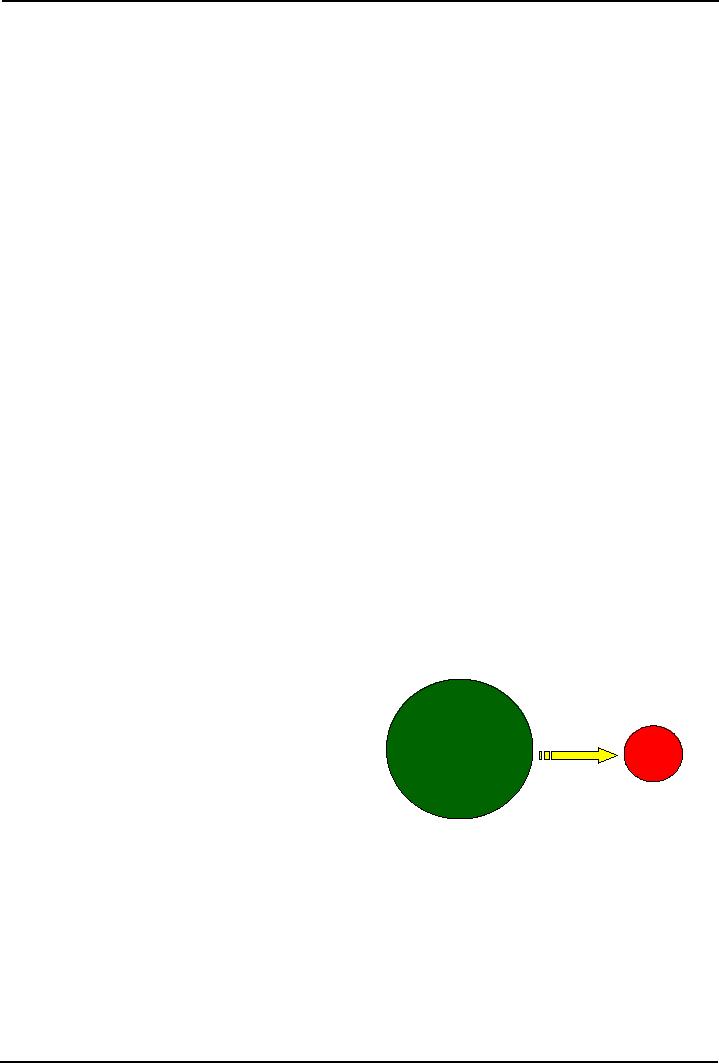
Social
Psychology (PSY403)
VU
Lesson
08
CONDUCTING
RESEARCH IN SOCIAL
PSYCHOLOGY
EXPERIMENTAL
METHOD
Aims:
To
make students understand how to conduct social
psychology research using diverse
scientific
methodologies.
Objectives:
Describe
experimental research
method
Describe
basic experimental design
Understand
differences between field and
laboratory research
methods
Understand
experimental research
designs
Understand
complex laboratory
designs
Experimental
methods
Experimental
methods are
research designs to examine
cause-effect relationships.
The
variable that is manipulated is
called the independent
variable, while the
variable whose
changes
are
considered to be the effect of the manipulated
changes in the independent variable is
called the
dependent
variable (e.g.,
varying lighting conditions and
performance of students)
Experimental
and control groups are two
main groups used in experimental
methods
Basic
Experimental Design
Figure
1 illustrates a basic experimental design
using random sampling procedure
Figure
1
Unfortunately,
we are seldom able to
obtain
such
a sample. We must, therefore,
often rely
Basic
Experimental Design
(simple,
on
using subjects who are
readily available -a
syst.)
convenience
sample - and then split them
into
two
groups using a technique called
"random
assignment."
Random
Figure
2 illustrates a basic experimental
design
Sampling
Random
Population
using
cluster sampling technique, as
mentioned
Sample
above.
35
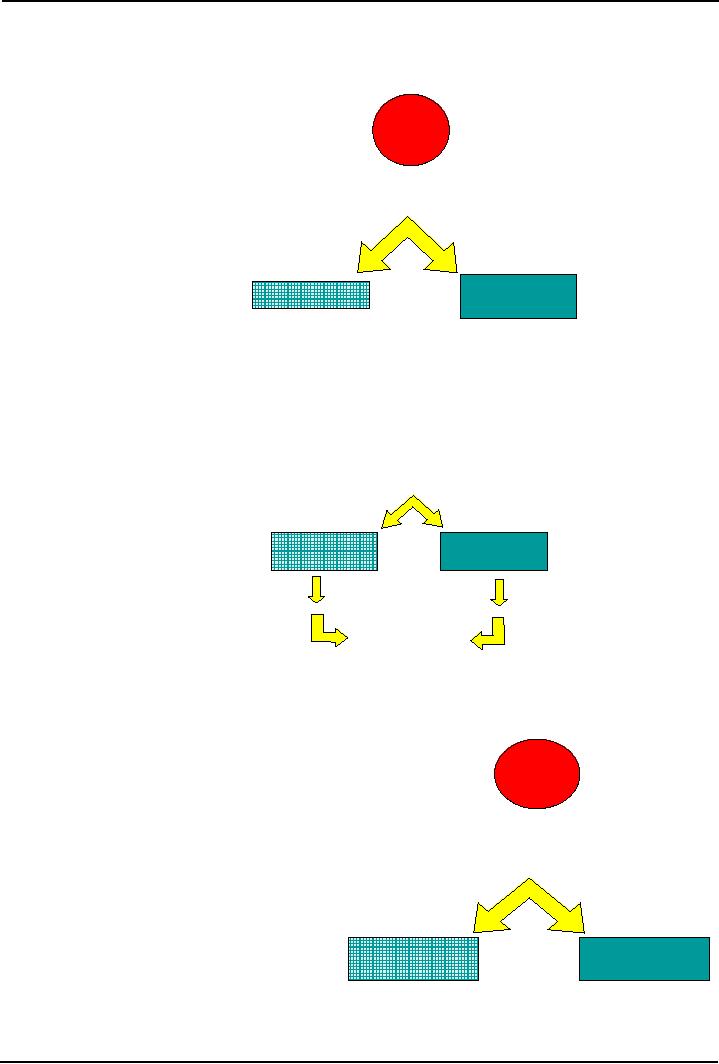
Social
Psychology (PSY403)
VU
Figure
2
Basic
Experim ental D esign (cluster
sam
ple)
Convenience
Sample
Random
Assignment
Experimental
Control
Group
Group
Figure
3 illustrates
the use of control and experimental
groups and the manipulation of
independent
variable
B
a s ic E xp e rim e n ta l D e s ig n
Present
Independent
V ariable
Experim
ental
C
ontrol G roup
G
roup
M
easure
D
ependent V ariable
C
o mpare
G
roups
B
a s ic E x p e r im e n t a l D e s ig n
Figure
4 tests the hypothesis that the
use
of
highlighters in text can
increase
C
onvenien ce
learning.
First of all subjects will
be given
S
am p le :
U
ndergraduate
several
pages to read. After
they have
S
tuden ts
done
so, they will be dismissed
and asked
R
a n d om A ssign m e n t
to
return to the experimental lab the
next
day.
H
igh ligh te rs fa c ilita te m e m o ry
of facts read f ro m te x tb oo
ks"
E
x p e r im e n ta l
C
o n tr o l G r o u p
G
roup
36
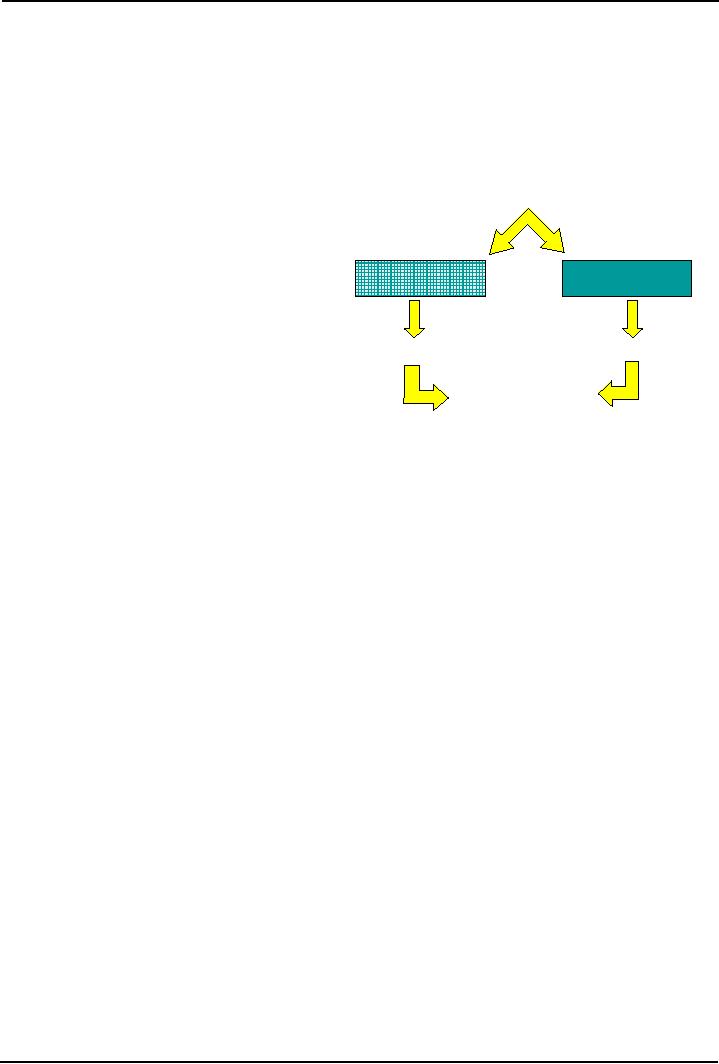
Social
Psychology (PSY403)
VU
Figure
5: Each
subject is given five pages
from an Introductory Psychology
text and told to read
the
pages carefully because they
will be tested on the material
next day. The subjects
are dismissed after
they
finish reading and asked to
return the next day. The
quiz next day will
determine whether
availability
of
highlighters helped greater learning or
not. Highlighters will only
be available to the experimental
group.
Basic
Experimental Design
Experimental
Method:
Description
Present
Independent Variable
Because
correlational studies
Availability
of Highlighter
cannot
definitively tell us why
variables
are
related to one another,
social
Highlighter
Available
psychologists
use
experimental
No
Highlighter
methods
to
examine cause-effect
relationships.
In an experiment, the
Experimental
Group
Control
Group
scientist
manipulates one variable by
Measure
exposing
research participants to it at
Dependent
Variable: Number
of
contrasting
levels (for example,
high,
correctly
recalled facts on quiz
medium,
low, no exposure), and then
observes
what effect this
manipulation
has
on the other variable that
has not
Compare
Groups
been
manipulated. The variable
that is
manipulated
is called the independent
variable, and it is
the one the experimenter is testing as
the possible
cause
of any changes that might
occur in the other variable. The
variable whose changes are
considered to
be
the effect of the manipulated changes in
the independent variable is called the
dependent
variable. The
dependent
variable is the response measure of an
experiment that is dependent
on
the participant's response
to
the experimenter's manipulation of the setting
(the independent
variable)
A
number of experimental studies have
explored whether watching
violent entertainment
programs
leads
to increased aggressiveness in children.
For example, Jacques-Philippe Leyens and
his colleagues
(1975)
conducted an experiment in a Belgian
private institution for secondary-school
boys. The
independent
variable in this study was
exposure to violent films. In two
cottages at the school, boys were
shown
a violent film every night
for one week (for
example, Bonnie
and Clyde, The Dirty
Dozen). The
boys
in two other cottages were shown the
same number of nonviolent films
during the same period of
time
(for
example, Lily,
Daddy's Fianc�e.
Significant
differences were found between the two
groups of boys, with the treatment
group
exhibiting
higher levels of aggression
both toward other boys and
toward inanimate objects. Based on
these
findings,
the social psychologists concluded that exposure to
violent films had indeed
caused increased
aggressiveness.
FIELD
EXPERIMENTS
The
study just described is a special
type of experiment called a
field
experiment, which is
similar
to
the more common laboratory
experiment, except that
it is run in a natural setting, and
participants often
do
not realize they are
being studied. This greater
realism increases the study's
external
validity, which
is
the
extent to which its findings
can be generalized to people beyond
those in the study
itself.
Unfortunately,
one drawback to field experiments is that
researchers have less control
over what is
happening
to each participant during the
study because they are in a
setting where many variables
are
uncontrollable.
These problems of control decrease the
study's internal
validity, which is the
extent to
which
cause-and-effect conclusions can validly be
made (Cook & Shadish,
1994).
LABORATORY
EXPERIMENTS
By
far, most social psychology experiments
are conducted in laboratories. As an
illustration,
consider
the following experiment investigating
the effects that two independent
variables, television
violence
and anger; have on boys' aggressive behavior. In
this study, Donald Hartmann
(1969) randomly
assigned
teenage boys to different levels of the
two independent variables. At the
beginning of the
experiment,
the boys, anger was manipulated by
either having a confederate
of
the experimenter--who
37
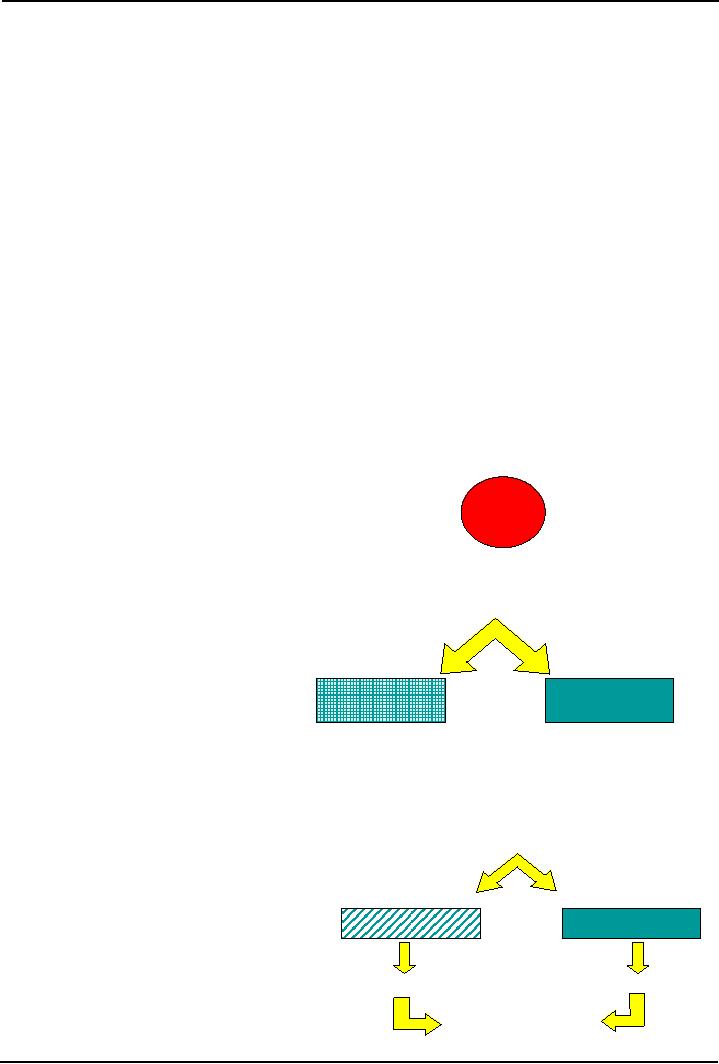
Social
Psychology (PSY403)
VU
was
posing as a fellow participant--insult
him or treat him in a neutral
fashion. Following the anger
manipulation,
the boys were assigned to one of three
film conditions lasting two
minutes. The first
minute
of
each film showed two boys
shooting baskets on a basketball
court. For the remaining
minute, the boys in
the
control group film merely
played basketball, while in the
two treatment-group films one of the
boys
began
beating the other following an
argument
After
viewing the film, each boy
participated in a seemingly unrelated
learning study. As the
"teacher"
in the study, the participant was
instructed to administer an electrical
shock to a "learner"
whenever
the learner made a mistake on the
learning task. The learner
was the confederate who had
either
insulted
the participant or treated him neutrally.
The intensity of the shock
chosen by the boys was the
dependent
variable. In reality, no shocks were
ever delivered, but the boys were
not aware of this until
the
end
of the experiment. As predicted, boys
exposed to a violent film and boys
previously angered tried
to
deliver
stronger shocks to the learner than
did boys in the control conditions.
Further, boys who had
been
both
angered and exposed to a violent
film chose the strongest
shock levels of the six groups of boys.
Thus,
the
combination of being exposed to a
violent film while angry
caused the greatest amount of
aggression.
The
experiment of Hartman is an example of
complex experiments, which is illustrated
in the
following
complex Lab designs.
Complex
Lab designs
Figures
6 and 7 show a complex design
with 2 independent variables
and 2 experimental and
one
control
group.
Figure
6
L
a b o r a t o r y E x p e r im e n t s D o n a ld
H
a r tm a n n 's s tu d y ( 1 9 6 9 )
C
on ven ience
Sam
p le:
U
ndergradu ate
Studen
ts
R
a n d o m A s sig n m e n t
C
o m bination of a nger a nd violent m
ovie v iew ing pro m
otes aggression
E
x p e rim en ta l
C
o n tr o l G r o u p
G
ro up s 1 & 2
Figure
7 shows
the manipulation of independent
variables
Complex
Experimental Design: Interaction
Present
Independent Variable
Induced
anger + violent movie
1.
Anger induced
1.Neutral
treatment
2.
Violent movie
2.Neutral
movie
Control
Group
2
Experimental Groups
Measure
Intensity
of shocks delivered to
confederate
Compare
Groups
38
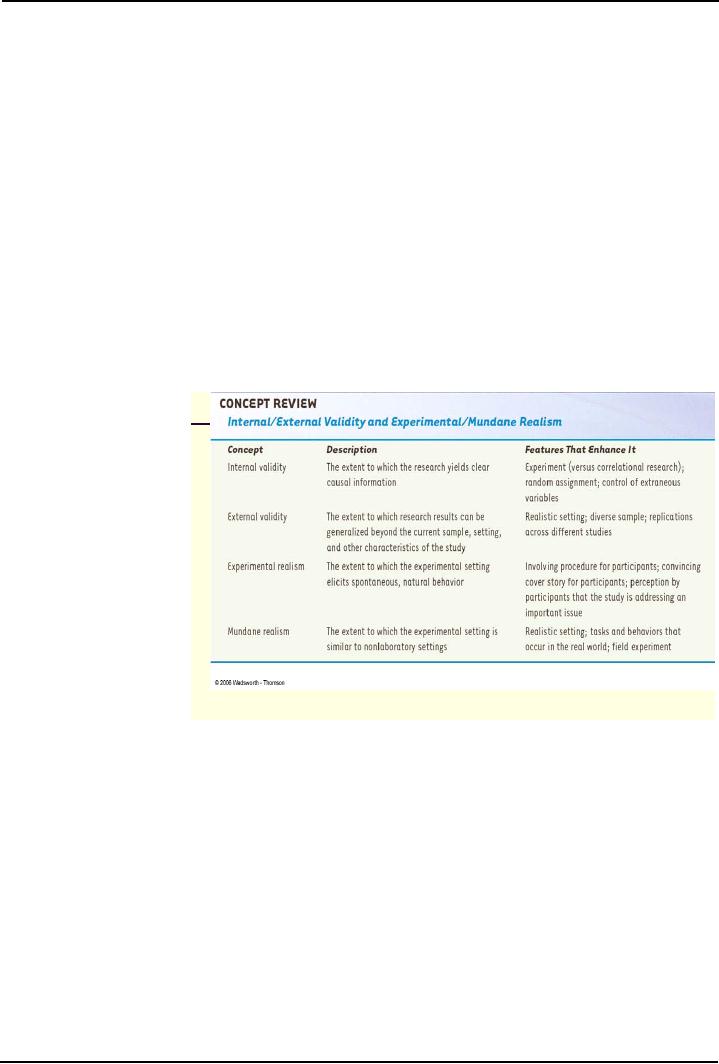
Social
Psychology (PSY403)
VU
The
main advantage of a lab experiment
like Hartmann's is that variables
can be well
controlled,
thus
increasing internal validity. An
important component of this control is
that participants can
be
randomly
assigned to the different levels of the
independent variable.
Unfortunately,
because of the researcher's desire to
control as much of the experimental
situation as
possible
in order to properly assign
causality, an air of artificiality
may exist in the lab
(Gosling, 2004;
Rozin,
2001).
Making
Experiments Real
Experimenters
recognize two types of realism
Experimental
realism
Does
the experimental situation feel real to
the participants in that
situation?
Mundane
realism
Does
the experiment have the look
and feel of situations in
the outside
world?
Table
1 illustrates
the relationship between internal and
external validity, as well as between
both forms of
realism.
Experimental
Designs
Independent
measures
designs
Repeated-measures
designs
Counterbalancing
is
applied
to reduce order
effect
of
same
individuals
exposed to
2
or more conditions
called
ABBA design:
Changing
the sequence
of
conditions for the
participants;
Source:
Brechler et al. 2006, Social
Psychology Alive
advantages
are less
subject
variability, and more strong conclusions about
causality
Matched
participants
Conclusion: There
is no one best method in all
research settings. In each
investigation, social
psychologists
must decide what method
provides the best
opportunity of meeting the study's
goals.
39
Table of Contents:
- INTRODUCTION TO SOCIAL PSYCHOLOGY:Readings, Main Elements of Definitions
- INTRODUCTION TO SOCIAL PSYCHOLOGY:Social Psychology and Sociology
- CONDUCTING RESEARCH IN SOCIAL PSYCHOLOGY:Scientific Method
- CONDUCTING RESEARCH IN SOCIAL PSYCHOLOGY:Evaluate Ethics
- CONDUCTING RESEARCH IN SOCIAL PSYCHOLOGY RESEARCH PROCESS, DESIGNS AND METHODS (CONTINUED)
- CONDUCTING RESEARCH IN SOCIAL PSYCHOLOGY OBSERVATIONAL METHOD
- CONDUCTING RESEARCH IN SOCIAL PSYCHOLOGY CORRELATIONAL METHOD:
- CONDUCTING RESEARCH IN SOCIAL PSYCHOLOGY EXPERIMENTAL METHOD
- THE SELF:Meta Analysis, THE INTERNET, BRAIN-IMAGING TECHNIQUES
- THE SELF (CONTINUED):Development of Self awareness, SELF REGULATION
- THE SELF (CONTINUE…….):Journal Activity, POSSIBLE HISTORICAL EFFECTS
- THE SELF (CONTINUE……….):SELF-SCHEMAS, SELF-COMPLEXITY
- PERSON PERCEPTION:Impression Formation, Facial Expressions
- PERSON PERCEPTION (CONTINUE…..):GENDER SOCIALIZATION, Integrating Impressions
- PERSON PERCEPTION: WHEN PERSON PERCEPTION IS MOST CHALLENGING
- ATTRIBUTION:The locus of causality, Stability & Controllability
- ATTRIBUTION ERRORS:Biases in Attribution, Cultural differences
- SOCIAL COGNITION:We are categorizing creatures, Developing Schemas
- SOCIAL COGNITION (CONTINUE…….):Counterfactual Thinking, Confirmation bias
- ATTITUDES:Affective component, Behavioral component, Cognitive component
- ATTITUDE FORMATION:Classical conditioning, Subliminal conditioning
- ATTITUDE AND BEHAVIOR:Theory of planned behavior, Attitude strength
- ATTITUDE CHANGE:Factors affecting dissonance, Likeability
- ATTITUDE CHANGE (CONTINUE……….):Attitudinal Inoculation, Audience Variables
- PREJUDICE AND DISCRIMINATION:Activity on Cognitive Dissonance, Categorization
- PREJUDICE AND DISCRIMINATION (CONTINUE……….):Religion, Stereotype threat
- REDUCING PREJUDICE AND DISCRIMINATION:The contact hypothesis
- INTERPERSONAL ATTRACTION:Reasons for affiliation, Theory of Social exchange
- INTERPERSONAL ATTRACTION (CONTINUE……..):Physical attractiveness
- INTIMATE RELATIONSHIPS:Applied Social Psychology Lab
- SOCIAL INFLUENCE:Attachment styles & Friendship, SOCIAL INTERACTIONS
- SOCIAL INFLUENCE (CONTINE………):Normative influence, Informational influence
- SOCIAL INFLUENCE (CONTINUE……):Crimes of Obedience, Predictions
- AGGRESSION:Identifying Aggression, Instrumental aggression
- AGGRESSION (CONTINUE……):The Cognitive-Neo-associationist Model
- REDUCING AGGRESSION:Punishment, Incompatible response strategy
- PROSOCIAL BEHAVIOR:Types of Helping, Reciprocal helping, Norm of responsibility
- PROSOCIAL BEHAVIOR (CONTINUE………):Bystander Intervention, Diffusion of responsibility
- GROUP BEHAVIOR:Applied Social Psychology Lab, Basic Features of Groups
- GROUP BEHAVIOR (CONTINUE…………):Social Loafing, Deindividuation
- up Decision GROUP BEHAVIOR (CONTINUE……….):GroProcess, Group Polarization
- INTERPERSONAL POWER: LEADERSHIP, The Situational Perspective, Information power
- SOCIAL PSYCHOLOGY APPLIED: SOCIAL PSYCHOLOGY IN COURT
- SOCIAL PSYCHOLOGY APPLIED: SOCIAL PSYCHOLOGY IN CLINIC
- FINAL REVIEW:Social Psychology and related fields, History, Social cognition